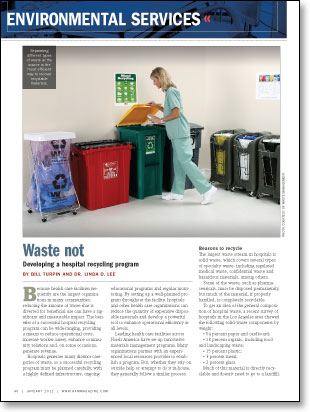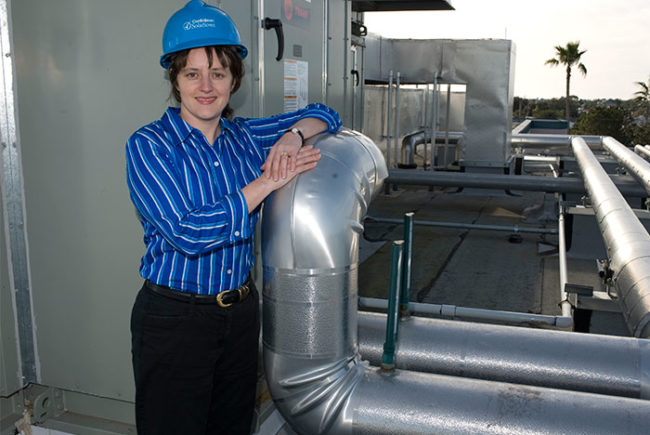 Because health care facilities frequently are the largest organizations in many communities, reducing the amount of waste that is diverted for beneficial use can have a significant and measurable impact. The benefits of a successful hospital recycling program can be wide-ranging, providing a means to reduce operational costs, increase worker safety, enhance community relations and, on some occasions, generate revenue.
Because health care facilities frequently are the largest organizations in many communities, reducing the amount of waste that is diverted for beneficial use can have a significant and measurable impact. The benefits of a successful hospital recycling program can be wide-ranging, providing a means to reduce operational costs, increase worker safety, enhance community relations and, on some occasions, generate revenue.
Hospitals generate many distinct categories of waste, so a successful recycling program must be planned carefully, with a highly defined infrastructure, ongoing educational programs and regular monitoring. By setting up a well-planned program throughout the facility, hospitals and other health care organizations can reduce the quantity of expensive disposable materials and develop a powerful tool to enhance operational efficiency at all levels.
Leading health care facilities across North America have set up innovative materials management programs. Many organizations partner with an experienced local resources provider to establish a program. But, whether they rely on outside help or attempt to do it in-house, they generally follow a similar process.
Reasons to recycle
The largest waste stream in hospitals is solid waste, which covers several types of specialty waste, including regulated medical waste, confidential waste and hazardous materials, among others.
Some of the waste, such as pharmaceuticals, must be disposed permanently, but much of the material, if properly handled, is completely recyclable.
To get an idea of the general composition of hospital waste, a recent survey of hospitals in the Los Angeles area showed the following solid-waste components by weight:
- 54 percent paper and cardboard;
- 18 percent organic, including food and landscaping waste;
- 15 percent plastic;
- 3 percent metal;
- 2 percent glass.
Much of this material is directly recyclable and doesn't need to go to a landfill. A significant problem, however, is that most facilities are not set up to separate and handle these materials properly. Recognizing the need to establish best practices and maintain constant oversight is key to a successful program.
Properly training staff and ensuring adequate procedures down to the level of clearly mandating use of correct waste containers is critical to ensuring program success and minimizing worker risk inside and outside a health care facility. By establishing and enforcing guidelines for properly categorizing waste, hospitals can avoid serious consequences.
For instance, red bag waste or radioactive material improperly included with regular solid waste greatly increases regulatory and compliance risk. This type of sorting error can result in serious health issues for employees and the public; it also can trigger audits and disruptions in workflow, creating a financial burden for the health facility.
The benefits of a well-designed waste program incorporating recycling are myriad: keeping staff safe; improving compliance; reducing environmental impact; and helping the facility manage community and regulatory affairs.
It can change the way facilities manage their waste streams before they leave the building. But, above all, the most compelling reason to recycle is cost. On average, medical waste is five times more expensive to discard than solid waste, and solid waste is more expensive to dispose than to recycle.
Necessary steps
The initial challenge of recycling in the health care setting is the diversity of waste. The goal should be to manage all waste at a high level and reclassify materials from one category to another as needed.
If health care workers fail to segregate waste properly, they create a larger flow of materials into the regulated stream than is needed, resulting in more negative employee events, more cost and more compliance documentation.
A brief overview of the necessary steps for creating a health care recycling program includes the following:
Perform an audit. This should be as comprehensive as the organization can afford, and must answer as many basic questions as possible. What is the state of the facility's current disposal practices? Where are all the facility's disposal locations? Where are different types of waste most often handled?
Additionally, an estimate of the quantity of materials that will be directed to recycling facilities should be developed. Local and state authorities should be contacted for additional guidelines, resources and explanations of any regulations that will impact the scope of the recycling program.
Identify local resources. What facilities and brokers are in the area to handle the facility's recycled waste stream? How will materials need to be sorted? What quantities are required and what are the prices? Commodity prices for such materials as cardboard and plastic are often volatile, which can have a negative impact on a program that has based projections on stable prices. Partnering with a resources provider who can navigate these fast-changing and inherently local markets is one way to deal with price fluctuations.
Establish goals. An environmental or sustainability committee should be set up internally or through external partners to set goals, a timeline, manageable milestones and well-defined metrics to measure success. Once these are determined, the committee can begin detailing the processes. This will include determining the number, type and placement of receptacles where staff generate the most recycling waste to maximize participation. The objective should be to consider ways of simplifying the process of discarding materials in the correct recycling bin rather than in the waste bin.
Maximize the value of materials. The internal team should work with external partners and brokers to maximize the value of the new recycling streams. By closely examining the product and monitoring the market value of different materials, program organizers can make decisions. From an operational perspective, it's easier to segregate material properly in the first place than it is to recycle a poorly segregated waste stream. Ongoing poor segregation will lead to higher cost and ultimately cause dealers to sever relationships.
Educate staff. Educating all hospital staff about proper segregation is key to successful recycling. Creating the culture to make the recycling program successful takes a sustained commitment by leadership from the top down, and funds for staff education. Quarterly flyers, e-mails or announcements to hospital staff are important tools to keep everyone focused on the program. State agencies, such as those listed on the National Recycling Coalition's website (www.nrc-recycle.org), and such organizations as Sustainable Hospitals (www.sustainablehospitals.org) can help facilities educate staff, patients and visitors on recycling. These often include samples of educational literature, links to resources, trained speakers and additional presentation materials.
Monitor and measure. Projections that were established at the beginning of the program should not be filed away in a spreadsheet. Rather, these become the lifeblood of a successful program. People at all levels of the process should know they are responsible for hitting specific goals. Publicizing select targets to the entire organization can be an excellent incentive. Initially, as the processes are refined and goals are fine-tuned, targets should be confined to the core organizing team so unrealistic goals will not hurt enthusiasm. As realistic targets are confirmed, however, metrics can be shared with all participants. Examples include weight of waste diverted from landfills or cost savings.
Earn recognition for the facility. Successes should be communicated through local, regional and national press outreach. Awards programs that can provide further validation and recognition should also be researched. Again, the facility should not be confined to local or regional programs; national and even international opportunities should be sought.
Highlighting success improves immediate community relations and can help raise the profile of a facility more broadly. It also can open the door for new partnerships and other relationships to expand and refine the existing recycling program.
Special considerations
While developing this program, health care organizations must pay particular attention to a number of special considerations that are peculiar to hospitals. They include the following:
HIPAA compliance. Health Insurance Portability and Accountability Act (HIPAA) standards for the handling and disposal of documents containing patient information are not incompatible with recycling, but it is critical that careful consideration be taken to ensure that procedures for document recycling are designed to ensure compliance. The most sustainable options for recycling documents regulated by HIPAA include the following:
- Contracting with a provider who can take material directly to bonded shredding facilities or bonded paper mills that also offer recycling;
- Installing on-site shredding equipment to destroy documents properly, then recycling the material.
Universal waste. Most health care facilities already are compliant with the proper disposal of regulated universal waste. This includes such items as batteries, cell phones, computers, computer monitors, electronic devices, fluorescent lamps, mercury waste, partially full aerosol cans and televisions.
This category poses health and environmental risk if put in the standard waste stream, but does not require the same level of special handling needed by more hazardous materials such as medical waste or industrial chemicals.
It is mandatory that everyone involved in the waste handling chain be aware of the procedures to deal with this waste separate from the hazardous materials stream, the regular waste stream and the recycling streams. For instance, fluorescent tubes are made of glass and can be included accidentally in glass recycling receptacles by uninformed staff. Similarly, partially full aerosol cans may end up in metal recycling receptacles.
Reprocessing medical devices. The practice of recycling medical tools and equipment has been somewhat contentious, but is monitored by the Food and Drug Administration and increasingly is adopted by hospitals nationwide. The practice can reduce waste and save facilities up to hundreds of thousands of dollars in operating costs. A limited range of equipment can be reprocessed, including compression sleeves, laparoscopic ports and pulse oximeters.
Starting small
The U.S. health care system contributes 1 percent of all the solid waste generated in the country.
The benefits of reducing this figure include economic rewards, environmental improvements, employee satisfaction gains and improved community relations.
By starting small and building on simple successes, all health care facilities easily can make this a part of their daily operations.
Bill Turpin is director of strategic business for WM Healthcare Solutions, a subsidiary of Waste Management Inc., Houston. Dr. Linda D. Lee is director of WM Healthcare Solutions. They can be contacted at bturpin@wm.com and llee4@wm.com.
| Sidebar - New York system records impressive recycling gains |
| In 2008, NewYork-Presbyterian Healthcare System in New York developed a comprehensive approach to managing waste at four of its facilities. Waste reduction and recycling initiatives involved coordinating procurement, safety, facilities and other departments within the hospital. Through interdepartmental cooperation, an operational audit and an employee education campaign organized by the hospital's waste services provider, NewYork-Presbyterian significantly reduced the amount of waste it generates and improved recycling rates. Large and small, the savings are adding up. From 2008 to 2009, the system's new mixed recyclable program diverted 900 tons of recyclables, including paper waste, which saved the equivalent of 15,300 trees. By reducing the volume of waste the facility generates, one campus has cut one trash compactor run every day, a 20 percent reduction that represents a savings of $10,000 per year. Pilot programs for battery recycling, toner recycling and other programs have been deployed and are at various stages of implementation. Education programs have proved popular with NewYork-Presbyterian's staff because the intuitive waste reduction and recycling systems improve their day-to-day efficiency. Overall, one campus saw a 40 percent drop in spending on solid waste from 2008 to 2009. NewYork-Presbyterian administrators now use waste metrics as a management tool. The system is instilling in its employees the fundamental idea that the strategic management of waste is a vital tool to reducing cost and improving efficiency at all levels. "We've worked with leading medical institutions across the country to manage their waste streams as a resource, as opposed to viewing it as just garbage," says Stefani Feldman, vice president at WM Healthcare Solutions, who is based at NewYork-Presbyterian. "Based on the successes we have seen with our partners, I think more hospitals will look at the bottom of their supply chains to find ways to improve their bottom line." |
| Sidebar - California hospital saves on its waste |
| In 2009, City of Hope Hospital in Duarte, Calif., began examining its waste stream as a potential source of cost savings. Partnering with its waste services provider, City of Hope began analyzing its waste-handling operations and habits across its 133-acre campus. In conjunction with its partner, City of Hope realized it could more efficiently source-separate different kinds of waste, improve workflow for medical providers, and reduce the amount of costly medical and hazardous-labeled waste it had been generating. Over the past year, this program has proved its value in several ways. City of Hope's staff members now dispose of medical waste directly into special square plastic bins, saving time and eliminating the risk of injury from manually separating waste into separate bags. By source-separating the waste into independent streams, such as medical waste, recyclables and electronics, the hospital reduced the volume of its waste entering landfills by approximately 33 percent and is recovering resources, including four unused medical devices that were sold for a return of tens of thousands of dollars. On the back end, the integrated system provides better management of the waste-hauler vendor contracts, as well as "pass-through" billing for all waste-related invoices, eliminating the involvement of accounts payable and saving time and money. City of Hope bundled the services and personnel into a flat monthly fee, providing for budgetary consistency. The program's speed of implementation and the rapid realization of financial and environmental returns has spurred other hospitals in the area to begin reviewing waste reduction and recovery processes in their facilities. |





